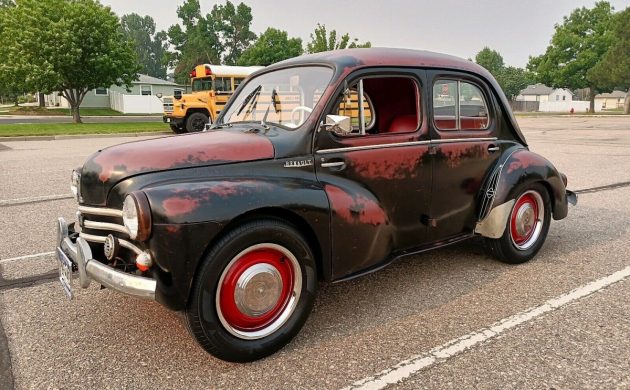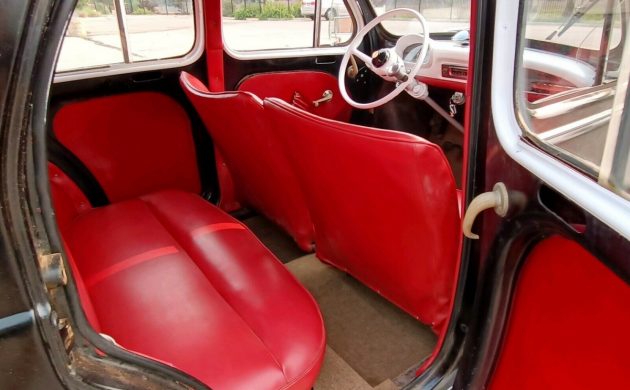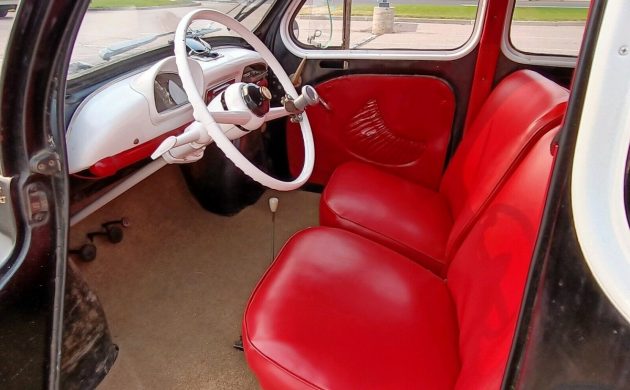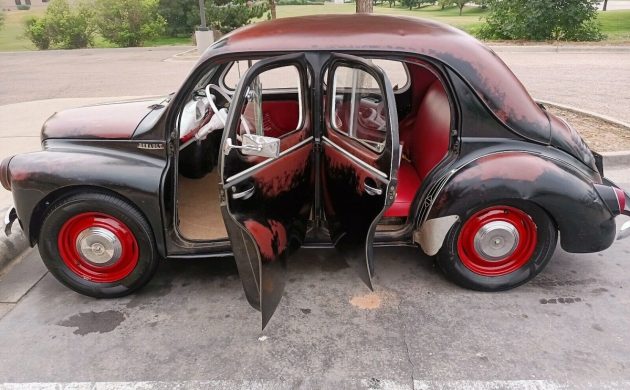One of the best ways to revive a war-torn economy is to get the population moving to commute to wherever they are needed to work. Vehicle production generates further employment within the community, and the now mobile population can travel further afield during their leisure time to further spread the wealth. However, this strategy would never work if these new cars were prohibitively expensive. Therefore, these offerings needed to be sold as affordable transport for the masses. This philosophy was embraced by many European countries following World War II, none more so than France. The result of this creative thinking was cars like the Renault 4CV. Introduced in 1947, it remained in production until replaced in 1961. As a car to liberate the population, it was a sales success. By the time Renault ceased production, more than 1.1 million of these little classics had rolled off the production line. This 1960 example is a gem. Its presentation is a long way from perfect, but that is one of the characteristics that adds to its overall charm. It runs and drives well, and it packs a couple of pleasant surprises in what is an affordable package. The owner has decided that the time has come for the 4CV to head to a new home, so he has listed it for sale here on eBay. It is located in Windsor, Colorado, and it could be yours with a BIN of $6,600.
Would you consider the 4CV to be the French equivalent of the VW Beetle? Both cars are rear-engined four-cylinder vehicles that can seat a family of five, and both were designed to be affordable transport for the general population. On those points, I think that the comparison is fair. The first thing that I noticed about this little 4CV was that it is finished in Black. This caught my attention because no Renault color charts from the era list this shade as an option. However, I know that it was available because my parents once owned one of these little classics. This car has developed a lovely aged appearance, which the owner refers to as a “Mother Nature” paint job. It has worn through in many places, but he has applied a clear coat over the exterior to prevent corrosion and rust from developing. The panels wear a few dings and dents, but none of these are bad enough to justify panel replacement. It appears that there are no rust issues worth noting, which is always good news in an older Renault. The exterior offers a striking contrast between the weathered paint and the freshly painted red wheels. Adding further appeal is the shining chrome and the crystal clear glass. This 4CV might not be a showroom-fresh classic, but I would be willing to guarantee that it would still command attention wherever it went.
I’ve often talked about how a classic can offer something special if a spotless interior contrasts a weathered exterior, and this Renault demonstrates this graphically. The owner has retrimmed this interior in Red vinyl, which seems to match the wheels. The overall impact is enhanced by a spotless white dash and steering wheel and the tan carpet that he has installed. The buyer won’t need to spend a dime inside the car because the upholstered surfaces show no evidence of wear, and the carpet is spotlessly clean. As affordable transport for the masses, Renault didn’t offer buyers many creature comforts in the 4CV. However, I noticed that this one sports an AM radio, although the owner indicates that this is the only item in the car that doesn’t work.
Unfortunately, the owner doesn’t supply any engine photos, and his information is contradictory. He states that the engine bay contains a 760cc four-cylinder engine that produces 27hp. However, Renault phased out the 760 for the 1950 model year, and even at its peak, that unit only pumped out 19hp. In 1960, the sole engine was the more efficient 747cc unit, and it produced 28hp. I suspect that this is what we’ll find fitted to this classic, and its power is fed to the rear wheels via a 3-speed manual transmission. Performance figures are all that you might expect from a car with such a modest power output. Point the 4CV down the ¼ mile, and the journey will take a leisurely 24.9 seconds. Given enough room and some patience on behalf of the driver, the little Renault should wind its way to a top speed of 62mph. However, you have to wait for a staggering 48.7 seconds before that happens. This little French classic appears to be in sound mechanical health. The owner has recently rebuilt the brakes, and he replaced the exhaust about 8-years-ago. He says that the vehicle runs and drives well, with no smoke or odd noises from that sweet little engine. The clutch and transmission work smoothly, so this 4CV is ready to hit the road.
As a car to get the masses mobile, the Renault 4CV was highly effective. It was affordable and cheap to run, which were two characteristics considered essential in post-war France. They remain affordable today, although pristine examples regularly sell for more than $11,000. This one isn’t perfect, but that’s where potential buyers may face a dilemma. Achieving perfection would seem possible with some minor panel work and a fresh coat of paint. That’s not going to be an expensive process, and when combined with the BIN price, it should be financially viable. Alternatively, it could be left as-is to wear its survivor tag like a badge of honor. Spotless presentation has its appeal, but I find this Renault has so much character now that I would hesitate to tamper with it. What about you?







To be picky, no 4CV I’ve ever seen or heard of had carpeting; all had rubber floor mats, which are now unobtainium. Also virtually impossible to find (and usually faded and clouded when you do) are the tail light lenses, which is why this one has VW Beetle rear lamps. There’s no doubt it has the 747cc engine, though I remember seeing one or two whose daredevil owners transplanted Dauphine 845cc engines and four-speed gearboxes, giving them a stirring 32 horses to deal with!
$6600? Not from me. Of course I’m biased; mine cost a whole $150, and that was for a complete car plus a second body shell and some (used) spares.
You can get those items in France. Most things are remanufactured for these cars
Going through most of France to get to the ’76 Le Mans race there were thousands of these cars running around all over the place. Say what you want but the average Frenchman obviously loved them.
They were good rally and race cars in the 50s. And you can still find the occasional Frankenstein 750 special at a regional French hill climb.
Any engine pics?
It was the 2CV that got France back on a level economic footing after the war. They were cheap to manufacture and cheap to buy, and Renault sold a ton of them. They were also surprisingly safe because the body was a “crumple zone”! The 4CV was a bigger car, built and sold in not nearly in the same numbers.
How did Renault sell a ton of Citroens?
Renault sold many more R4s than Citroen sold 2CVs; I don’t know how the 4CV/2CVs compare.
Enough with the clearcoat already. This fad seems to be lasting as long as people wearing ball caps backwards.
Along with “patina”. It screams “I can’t afford a paint job after overpaying for this jalopy.”
Perfect for a Kawasaki or Suzuki 1000 cc engine transplant, would make a great sleeper!
The French Beetle? They wish!
Well Steve they put beetle tail lights on it. LOL
Well….Dr Ferdinand Porsche was invited to Paris after WW2 as a consultant on the 4CV. What he didn’t know was that this was a sting, so he gound himself in prison as a “person of interest”. To be fair he had had a very close relationship with Hitler in developing the beetle, not to mention some major wartime “defense” projects.
Son Ferry started to build 2 seaters in Austria in order to bail the aged parent out. So the 4CV may be seen as sparking Porsche Gmbh. Doubt if tjere is one in the museum.
Jean Reďélé also staryed by tuning 4CV, the cars won classes in Le Mans and Mille Miglia. He then went on to build Alpine, based around 4CV components. An Alpine finished 3rd at Le Mans this afternoon.
Old man Porsche, possibly the greatest constructor of all times (automobiles, race cars, tractors, tanks, electric trains etc.,etc) ran an automotive plant in France during WW2, furnishing well paid employment for a large number of Frenchmen. Working conditions were generally better than those in pre-war years. His contact with Hitler was limited to advising Hitler on the VW, no more. To imply that there was something dubious or sinister about any of this is dishonest and malicious. Porsche never hurt a fly and was imprisoned by the French under false pretenses; they had kidnapped him and the German government had to pay a king´s ransom to free him; this whole thing made the French governnment of the time look like criminals a la Capone.
What isn’t widely known is that the good Dr. Porsche was an honorary colonel in the SS! A certain well known comedian is purported to have a photo of him in his SS uniform but refuses to publish it. Ironic as this comedian does not hide his Jewish heritage.
The 4CV was exported to Germany. Some were assembled in England and Australia. A commercial derivative was also made in Australia
“Well paid employment?” Really? The country was occupied by Nazis and conditions were basically prison labor. They were building war materiel to kill Americans and our allies. I guess “well paid” means they got a little extra bread. Food was basically all exported to Germany.
The rules governing this web site do not allow mw to answer propaganda trolls. Suffice it to quote the french communist philosopher Sartre who said: ¨We French have never been more free then under the so-called occupation.¨